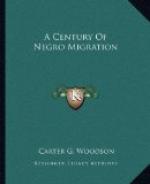This question having been seemingly settled, Anthony Benezet, who for years advocated the abolition of slavery and devoted his time and means to the preparation of the Negroes for living as freedmen, was practical enough to recommend to the Congress of the Confederation a plan of colonizing the emancipated blacks on the western lands.[14] Jefferson incorporated into his scheme for a modern system of public schools the training of the slaves in industrial and agricultural branches to equip them for a higher station in life. He believed, however, that the blacks not being equal to the white race should not be assimilated and should they be free, they should, by all means, be colonized afar off.[15] Thinking that the western lands might be so used, he said in writing to James Monroe in 1801: “A very great extent of country north of the Ohio has been laid off in townships, and is now at market, according to the provisions of the act of Congress.... There is nothing,” said he, “which would restrain the State of Virginia either in the purchase or the application of these lands."[16] Yet he raised the question as to whether the establishment of such a colony within our limits and to become a part of the Union would be desirable. He thought then of procuring a place beyond the limits of the United States on our northern boundary, by purchasing the Indian lands with the consent of Great Britain. He then doubted that the black race would live in such a rigorous climate.
This plan did not easily pass from the minds of the friends of the slaves, for in 1805 Thomas Brannagan asserted in his Serious Remonstrances that the government should appropriate a few thousand acres of land at some distant part of the national domains for the Negroes’ accommodation and support. He believed that the new State might be established upwards of 2,000 miles from our frontier.[17] A copy of the pamphlet containing this proposition was sent to Thomas Jefferson, who was impressed thereby, but not having the courage to brave the torture of being branded as a friend of the slave, he failed to give it his support.[18] The same question was brought prominently before the public again in 1816 when there was presented to the House of Representatives a memorial from the Kentucky Abolition Society praying that the free people of color be colonized on the public lands. The committee to whom the memorial was referred for consideration reported that it was expedient to refuse the request on the ground that, as such lands were not granted to free white men, they saw no reason for granting them to others.[19]




